

PubDat_170658. Education Update:Make Parents Your Partners:Can Mobile Devices Transform Education? The popularity of smartphones, including Droids, iPhones, and BlackBerries, that now have GPS, texting, voice, and multimedia capabilities has prompted industry and education reformers to shine the light on these mobile devices as vehicles suitable for transforming K–12 learning for the 21st century.

Although they present challenges as well as potential benefits, education experts reason that these powerful small computers motivate students; provide constant access to the wealth of knowledge, tools, and experts on the web; and are cheaper and more plentiful than laptops or desktop workstations. "A big choice for us is: we have this very flexible tool, much more like a Swiss army knife than a hammer. What do we want to use it for? " says Christopher Dede, Timothy E. Wirth Professor in Learning Technologies at Harvard University's Graduate School of Education. In a 2009 survey, nearly 300,000 students stated their preference for the use of mobile devices.
Pedagogical arguments for Augmented Reality as an educational tool - Jisc RSCs Blog. Share Two weeks ago I was invited to the Mimas presentation to showcase the Scarlet and Scarlet+ project outcomes.
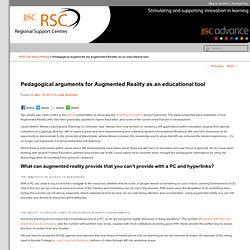
The ideas presented were examples of how Augmented Reality (AR) had been practically applied to Higher Education, and some of the current ones that are in development. Laura Skilton, Mimas Learning and Teaching Co-ordinator, said ”Mimas have now worked on numerous AR applications within education ranging from special collections to a geology field trip. We’ve learnt a great deal from experimenting and collecting student and academic feedback.
We used this showcase as an opportunity to demonstrate to the University of Manchester, where Mimas is based, this knowledge and to show that AR can enhance the student experience – it’s no longer just a gimmick, it is being embedded into teaching.” Whilst there is enthusiasm within areas where AR developments have taken place, there are still many in education who see this as a gimmick. Augmented reality in education: teaching tool or passing trend? What some may call an 'unsurprising' 71% of 16 to 24-years-olds own smartphones, so why aren't teachers utilising these in the classroom or campus?
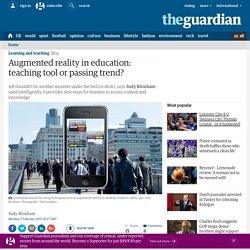
Is the use of these devices going to detract from the learning process or contribute to future workplace skills? Should teachers be using techniques such as augmented reality (AR) to engage students and develop their skills for the modern world? Well, I say 'yes'. I believe we should be embracing these opportunities. Augmented Reality Learning Tools for Anatomical Education. In this project, Fraunhofer IDM@NTU and the Lee Kong Chian School of Medicine (NTU) collaborate to bring the study of anatomy to the next level.
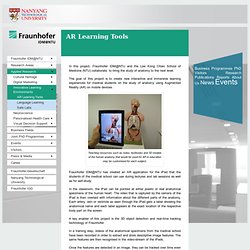
The goal of this project is to create new interactive and immersive learning experiences for medical students on the study of anatomy using Augmented Reality (AR) on mobile devices. Teaching resources such as notes, textbooks and 3D models of the human anatomy that would be used for AR in education may be customised for each subject. Fraunhofer IDM@NTU has created an AR application for the iPad that the students of the medical school can use during lectures and lab sessions as well as for self-study.
In the classroom, the iPad can be pointed at either plastic or real anatomical specimens of the human heart. The video that is captured by the camera of the iPad is then overlaid with information about the different parts of the anatomy. A key enabler of this project is the 3D object detection and real-time tracking technology of Fraunhofer. My library.
How To Use Augmented Reality In Education. When you were a kid, did you watch RoboCop and totally love the heads-up display?
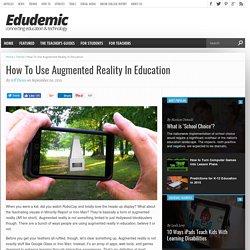
What about the fascinating visuals in Minority Report or Iron Man? They’re basically a form of augmented reality (AR for short). Augmented reality is not something limited to just Hollywood blockbusters though. There are a bunch of ways people are using augmented reality in education, believe it or not. Before you get your feathers all ruffled, though, let’s clear something up.
In an effort to shed some light on the current tools and teachers using AR, I thought it might be useful to assemble a list of what we’re seeing these days. In any case, here are just a handful of interesting AR use cases that you should check out. Project Glass The most famous AR project is being, of course, led by the folks at Google. MITAR Games Star Walk. Augmented Reality Brings New Dimensions to Learning. Editor's Note: Drew Minock, who co-wrote this piece, is an elementary teacher, co-founder of the popular education blog Two Guys and Some IPads, and is one of the voices on "The Two Guys Show" podcast.
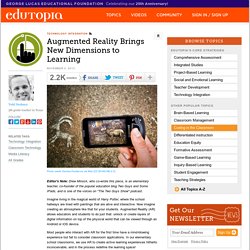
Imagine living in the magical world of Harry Potter, where the school hallways are lined with paintings that are alive and interactive. Now imagine creating an atmosphere like that for your students. Augmented Reality (AR) allows educators and students to do just that: unlock or create layers of digital information on top of the physical world that can be viewed through an Android or iOS device. Most people who interact with AR for the first time have a mind-blowing experience but fail to consider classroom applications. Elearn Magazine: Augmented Reality: A new way of augmented learning.
Augmented learning is defined as an on-demand learning technique where the learning environment adapts to the needs and inputs from learners [1].
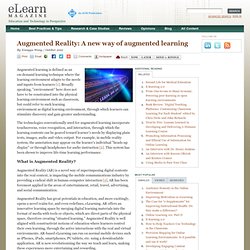
Broadly speaking, "environment" here does not have to be constrained into the physical learning environment such as classroom, but could refer to such learning environment as digital learning environment, through which learners can stimulate discovery and gain greater understanding. The technologies conventionally used for augmented learning incorporate touchscreens, voice recognition, and interaction, through which the learning contents can be geared toward learner's needs by displaying plain texts, images, audio and video output. For example, in mobile reality system, the annotation may appear on the learner's individual "heads-up display" or through headphones for audio instruction [2].
This system has been shown to improve life-time learning performance.